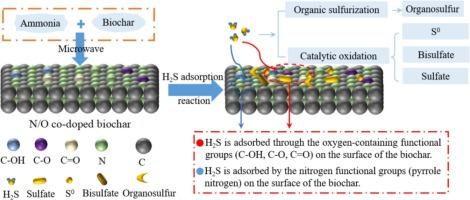微波辅助一步法制备N/O共掺杂生物炭吸附去除气态H2S
IF 4.3
2区 工程技术
Q2 ENGINEERING, CHEMICAL
引用次数: 0
摘要
本文采用简单有效的微波辅助一步改性法制备氮/氧共掺杂秸秆生物炭,并利用所制备的吸附剂对气态硫化氢进行高效脱除。考察了制备工艺参数对吸附剂脱硫性能的影响。研究了该吸附剂对H2S的吸附机理、动力学规律及再生特性。结果表明,微波辅助氮/氧共掺杂一步改性技术显著优化了生物炭的孔隙结构,实现了生物炭表面含氮和含氧官能团的同步加载。最佳制备条件为氨浓度为10 %,微波辐射时间为20 min。增加H2S入口浓度可缩短H2S的突破时间,而增加水蒸气含量和提高吸附温度均可显著促进H2S的脱除。改性生物炭对H2S的最大吸附量达到62.61 mg/g。结果表明,H2S通过含氮和含氧官能团的协同作用,在改性生物炭表面转化为单质硫、有机硫、硫酸氢盐和硫酸盐。改性生物炭的脱硫过程符合准一级动力学模型,因此外传质是H2S吸附的主要控制步骤。所开发的再生方法可以有效地恢复饱和生物炭的脱硫能力。本文章由计算机程序翻译,如有差异,请以英文原文为准。

Preparation of N/O co-doped biochar by microwave-assisted one-step method for adsorption removal of gaseous H2S
In this article, a simple and effective microwave-assisted one-step modification method was used to prepare nitrogen/oxygen co-doped straw biochar, and then the prepared adsorbent was used for efficient removal of gaseous hydrogen sulfide. The influences of preparation and process parameters on desulfurization performance of the adsorbents were assessed. The H2S adsorption mechanism and kinetic laws, and the regeneration characteristics of the adsorbent were studied. Results showed that the microwave-assisted nitrogen/oxygen co-doping one-step modification technology significantly optimized the pore structure of the biochar, and achieved the synchronous loading of nitrogen-containing and oxygen-containing functional groups on the surface of biochar. The optimal preparation conditions were 10 % ammonia concentration and 20 min microwave radiation time. Increasing H2S inlet concentration reduced the H2S breakthrough time, while increasing water vapor content and raising adsorption temperature both significantly promoted the H2S removal. The maximum adsorption capacity of the modified biochar for H2S reached 62.61 mg/g. It was demonstrated that H2S was converted into elemental sulfur, organic sulfur, bisulfate, and sulfate on the modified biochar surface through the co-action of nitrogen-containing and oxygen-containing functional groups. The desulfurization process over the modified biochar followed a pseudo-first-order kinetic model, and thus external mass transfer was the main controlling step for H2S adsorption. The developed regeneration method can effectively restore the desulfurization ability of the saturated biochar.
求助全文
通过发布文献求助,成功后即可免费获取论文全文。
去求助
来源期刊

Chemical Engineering Science
工程技术-工程:化工
CiteScore
7.50
自引率
8.50%
发文量
1025
审稿时长
50 days
期刊介绍:
Chemical engineering enables the transformation of natural resources and energy into useful products for society. It draws on and applies natural sciences, mathematics and economics, and has developed fundamental engineering science that underpins the discipline.
Chemical Engineering Science (CES) has been publishing papers on the fundamentals of chemical engineering since 1951. CES is the platform where the most significant advances in the discipline have ever since been published. Chemical Engineering Science has accompanied and sustained chemical engineering through its development into the vibrant and broad scientific discipline it is today.
 求助内容:
求助内容: 应助结果提醒方式:
应助结果提醒方式:


